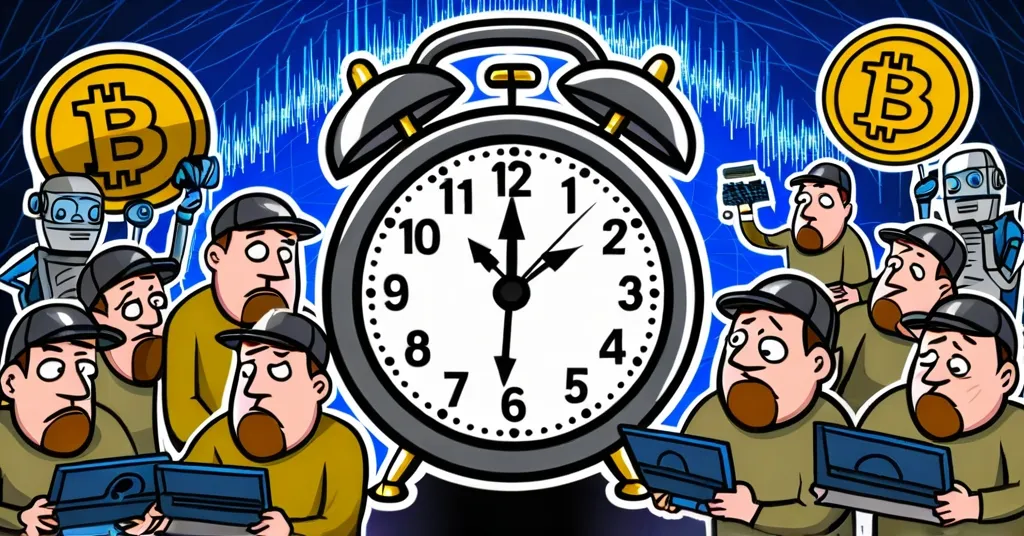Bitcoin Block Production Delay Sparks Debate on Network Stability and Efficiency

Bitcoin Block Production Glitch Raises Concerns Over Network Stability
Bitcoin’s block production recently experienced an 88-minute delay, sparking a debate about the stability and efficiency of its network.
- Bitcoin block production delay
- Impact on miners and network stability
- Varying perspectives on delays
- Mining difficulty adjustments and post-halving economics
On a typical day, Bitcoin’s network hums along, producing a new block roughly every 10 minutes. But when that clock ticks past the usual interval and stretches into an 88-minute delay, it’s not just a technical hiccup—it’s a moment that tests the resilience of the world’s leading cryptocurrency. Software engineer Neil Hartner took to X to report this significant glitch in Bitcoin’s block production process, which halted for 88 minutes.
This wasn’t an isolated incident; Hartner noted that such delays have occurred 21 times in 2025, often lasting over an hour. The reasons behind these delays are multifaceted, ranging from network congestion to low miner profitability and fluctuations in mining difficulty (how hard it is to mine new bitcoins). Mining difficulty, which adjusts every two weeks, plays a crucial role in keeping the network’s block production time consistent. The recent reduction to 108.1 trillion on January 27, 2025, might offer some respite to miners struggling with post-halving economics.
Not everyone views these delays with alarm. X user GREEK HODL argued that such occurrences are part and parcel of Bitcoin’s probabilistic nature. “Bitcoin doesn’t experience outages like other blockchains… block production is driven by hash rate probability (the speed at which miners solve complex math problems), meaning occasional delays are expected,” GREEK HODL stated, pushing back against the narrative of instability.
Despite these differing viewpoints, the delays raise serious questions about the efficiency and reliability of Bitcoin’s network. Prolonged block production times can affect transaction processing and miner profitability, which are crucial for maintaining the network’s decentralized integrity. Miners have been feeling the squeeze, with profitability taking a hit after the April 2024 halving. Some have diversified into AI and high-performance computing to cushion the impact, while others have adopted Bitcoin treasury strategies to capture long-term price appreciation. It’s like watching miners juggle between solving puzzles and running a side hustle with their AI-powered gadgets!
The interconnectedness of the mining and AI sectors means that shifts in one can ripple through to the other, as seen with the significant drop in AI stock values following the release of cost-effective models like DeepSeek R1. This diversification isn’t just about making ends meet; it’s about miners adapting to a world where the rules of the game keep changing.
The debate over these block production delays is more than just a technical discussion; it’s a reflection of the broader conversation on Bitcoin’s future. Are these delays a sign of underlying issues that need addressing, or are they simply the expected variability of a decentralized system? The answer might lie somewhere in between, with the need for core developers to consider updates to improve network stability while acknowledging the inherent unpredictability of Bitcoin’s blockchain.
As we navigate these waters, it’s clear that Bitcoin’s journey is far from smooth but remains undeniably fascinating. The resilience of its network, the strategies of its miners, and the debates that fuel its community all contribute to a narrative that’s as complex as it is compelling. And as champions of decentralization, freedom, and privacy, we must keep a critical eye on these developments, knowing that they shape the future of our digital economy.
Key Takeaways and Questions
- What caused the recent delay in Bitcoin’s block production?
The delay could be attributed to network congestion, miners shutting down operations due to low profitability, or fluctuations in mining difficulty.
- How frequent are these block production delays?
Neil Hartner reported 21 similar incidents in 2025, each lasting over 60 minutes.
- What is the impact of these delays on Bitcoin’s network?
These delays raise concerns about Bitcoin’s network stability and efficiency, potentially affecting transaction processing and miner profitability.
- How does the mining difficulty adjustment affect block production?
Mining difficulty adjusts every two weeks, and prolonged delays could have broader implications for transaction processing and miner profitability.
- What is the differing view on the significance of these delays?
While Neil Hartner sees the delays as a cause for concern, GREEK HODL argues that they are normal and expected due to the probabilistic nature of block production driven by hash rates.
“The glitch halted block production for 88 minutes—far exceeding the usual 10-minute interval.” – Neil Hartner
“Bitcoin doesn’t experience outages like other blockchains… block production is driven by hash rate probability, meaning occasional delays are expected.” – GREEK HODL



